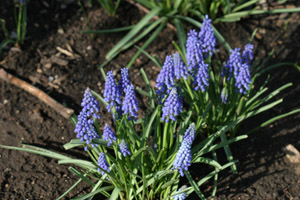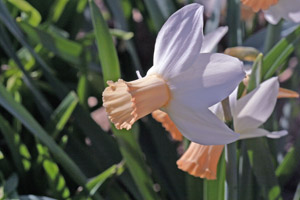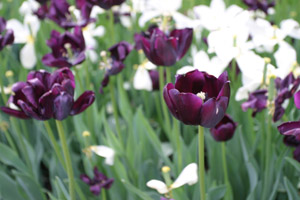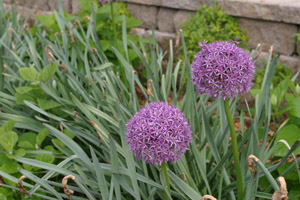G1742
Spring Flowering Bulbs
Selecting, planting, caring for, harvesting and forcing spring flowering bulbs are discussed in this publication.
Anne M. Streich, Extension Educator
Don E. Janssen, Extension Educator
Kathleen P. Cue, Extension Associate
- Site Selection and Design
- Site Preparation for Establishment
- Bulb Selection and Planting
- Maintenance
- Harvesting
- Forcing
- Acknowledgment
Bulbs are underground stems formed by fleshy scales attached to a basal plate (for example: tulip, narcissus and lily). Corms are underground swollen stems surrounded by dry, scale-like leaves (gladiolus, freesia and crocus). Tubers are swollen underground stems that are often irregularly shaped (dahlia, gloriosa and ranunculus). Rhizomes are horizontally creeping underground stems that produce aerial shoots from nodes (iris and convallaria). In this publication, all corms, tubers and rhizomes will be referred to as bulbs.
Most spring flowering bulbs are hardy perennials. Some, such as tulips and hyacinths, are short-lived or may never flower in Nebraska because of high soil temperatures or improper planting procedures.
Site Selection and Design
Bulbs are among the easiest plants to grow. Most bulbs need full sun or a minimum of six hours daily. Others, such as wood hyacinths, require partial shade. Few bulbs will thrive in heavy, constant shade. If reliable bloom is desired from year to year, the site should receive at least eight hours of full sunlight per day. Some areas near trees may receive full sun early in the season, before leaves have fully emerged and may be suitable for early flowering bulbs. All bulbs need well-drained soil to reduce rot while dormant. For this reason, areas that receive frequent moisture from lawn irrigation are not desirable planting sites.
Spring flowering bulbs may be used to provide early season color in the landscape while other plants are slowly developing. Some, such as grape hyacinths (Figure 1) and daffodils (Figure 2), can be planted in grassy areas and may spread or multiply to give a naturalized effect.
Bulbs planted in a southern exposure near a building or wall will encourage early foliage growth due to increased soil temperatures. Late spring freezes occasionally may cause foliage or flower damage on early emerging plants.
Homeowners can choose from hundreds of spring flowering bulbs varying in flower color, form and height. Among the most popular are tulip (Figure 3), narcissus, grape hyacinth, hyacinth and crocus. Less known spring flowering bulbs include scilla, allium (Figure 4) and Dutch iris.
Bulbs should be planted in waves or masses to give a natural appearance and the showiest color impact. Bulbs planted singly or in rows are not effective.
 |
 |
|
| Figure 1. Grape hyacinths | Figure 2. Daffodils | |
 |
 |
|
| Figure 3. Tulips | Figure 4. Allium |
Site Preparation for Establishment
A well-drained soil is essential for the survival of bulbs. All bulbs benefit from the addition of organic matter to the soil. Organic matter loosens the soil and adds essential nutrients. Thoroughly mix compost with loosened soil at the rate of 1 part organic matter to 4 parts soil. For example, 3 inches of organic matter should be incorporated to a depth of 12 inches.
When establishing a new bed of bulbs, the soil should be loosened to at least 4 inches below the suggested planting depth. For example, if the recommended planting depth is 6 inches, the bed should be prepared to at least 10 inches.
Bulb Selection and Planting
Bulbs available in garden centers vary considerably in quality. Make sure they are healthy and firm with strong growing points and unblemished skin. Avoid small, soft and diseased bulbs. Bulbs that are smaller than others of the same type often will not produce flowers during their first growing season.
Spring flowering bulbs should be planted in late September through October when soil temperatures fall below 60°F. This will allow a root system adequate time to develop before the ground freezes. If bulbs are purchased before planting time, keep them in a cool, dry area. A temperature of 60° to 65°F is cool enough to preserve the energy of the bulbs until they can be planted. Extended storage in high temperatures can damage flower buds within the bulb.
Dig and plant flower beds when the soil is fairly dry. Wet soil packs tightly around the bulb and retards growth. If you can crumble the soil between your fingers, it is dry enough for digging and planting.
Remove soil to the correct depth, as indicated in Table I. In loose, sandy soil, plant bulbs 1 to 2 inches deeper than the recommended depth.
Place the bulb in the hole with the pointed end up. Replace and firm the soil around the bulbs to ensure no large air spaces have formed. Water thoroughly, and in the absence of rainfall, water deeply once a week until the ground freezes. After ground freeze, add a 2 to 3 inch layer of organic mulch (wood chips, shredded bark, pine needles, etc.) to protect the bulbs.
| Table I. Bulb selection and planting. | ||||||
| Common name | Scientific name | Planting depth |
Spacing |
Flower height |
Flower Color | Comments |
Very Early Spring (March-April) |
||||||
| Glory-of-the-Snow | Chionodoxa luciliae | 2-3 |
3-4 |
4-6 |
Blue, white, pink | Naturalizes; use in rock gardens, borders |
| Golden crocus | Crocus chrysanthus | 3 |
3 |
4 |
Orange, white, yellow, blue | Small, earlier flowers than Dutch crocus |
| Dutch crocus | Crocus vernus | 3 |
4 |
6 |
White, yellow, blue, purple | Naturalizes; use in rock gardens, lawns and at the bases of trees |
| Winter aconite | Eranthis hyemalis | 3 |
2-6 |
4-6 |
Yellow | Naturalizes; moist soil |
| Common snowdrop | Galanthus nivalis | 4 |
2-4 |
4-6 |
White | Fertile soil; shade; naturalizes |
| Striped squill | Puschkinia scilloides | 3 |
4-6 |
4-6 |
Blue | Plant in large masses; self-seeds |
| Siberian squill | Scilla siberica | 3 |
4-6 |
4-8 |
Blue, white | Fertile soil; naturalizes in lawns |
Early Spring (April) |
||||||
| Common hyacinth | Hyacinthus orientalis | 6 |
8 |
6-10 |
Pink, blue, white | Fertile soil; good for forcing |
| Armenian Grape Hyacinth | Muscari armeniacum | 3 |
4 |
6-10 |
Blue | Grows best in cool, moist sites; plant in masses; multiples and self-seeds |
| Common grape hyacinth | Muscari botryoides | 3 |
4 |
4-8 |
Blue, white | Less robust than M. armeniacum; tends not to multiple or self-seed |
| Tulip (species and hybrids) | Tulipa kaufmanniana Tulipa fosteriana Single Early Double Early |
6 6 6 6 |
6 6 6 6 |
4-8 15-18 6-18 10-18 |
Yellow, orange, purple, red, white |
Good for rock gardens Large flowers; comes back year after year Often fragrant flowers Slightly later than the single early |
| Daffodils (divisions) | Miniature Trumpet Large cupped |
5 8 8 |
4 4 6 |
4-6 18-20 10-20 |
White, yellow, pink, orange, red | Good for rock gardens and forcing Naturalizes well |
Mid-Spring (late April-early May) |
||||||
| Crown imperial | Fritillaria imperialis | 6 |
8-12 |
24-28 |
Yellow, orange, red | Rich soil; shade to part shade; use in borders or naturalized areas |
| Checkered lily | Fritillaria meleagris | 4-6 |
4-6 |
10-15 |
White, purple, gray, bronze | Moist soils; drooping flowers |
| Tulips (species and hybrids) | Tulip greigii Mendel Darwin Triumph |
8 8 8 8 |
6 5 6 5 |
8-16 18-24 20-28 18-24 |
Many colors are available | Good for containers and forcing Good for forcing Large flowers; keep out of the wind |
Late Spring (May) |
||||||
| Spanish bluebells/Wood hyacinth | Endymion hispanica | 4 |
5 |
12-24 |
Blue, pink, white | Does well in heavy shade; good cut flower |
| Bearded iris | Iris hybrids | 1-2 |
4 |
30-36 |
Many colors are available | |
| Tulips | Parrot Double Late Lily Flowered Darwin Cottage Green Fringed |
8 8 8 8 8 8 8 |
6 6 6 6 6 6 6 |
18-22 16-24 18-24 24-32 22-30 20 18-26 |
Many colors are available | Excellent cut flower; protect from wind Plant in sheltered area Excellent for bedding and cut flowers Good cut flower |
Very Late Spring (June) |
||||||
| Giant flowering onion | Allium giganteum | 6 |
12 |
36-48 |
Pink | Large, globe-shaped cluster of flowers |
| Allium | Allium spp. | 6 |
6-12 |
18-48 |
Pink, white, purple | Several species and cultivars are available |
| Dutch hybrid iris | Iris hybrids | 6 |
4 |
18-24 |
White, yellow, orange, blue, purple | |
Maintenance
Remove faded flowers to prevent seed formation. Seed production takes energy away from the bulb and may reduce flowering the next year. Deadheading some types of tulips and daffodils can lengthen flowering time for up to two months.
Apply a balanced fertilizer, such as a 10-10-10, after the flowers have faded. This will help create a larger bulb to enhance next year’s bloom.
After bloom, the dying foliage can be hidden by the developing growth of other flowers and shrubs in the bed, although the leaves should receive some sunlight until they begin to yellow. Future flower production may be reduced by removing, braiding or tying the foliage.
After the leaves have turned yellow, cut and remove the foliage. Removal of dead foliage from the garden will help prevent diseases from affecting next year’s bloom. To hide unattractive, yellowing foliage, plant annual flowers in front of spring flowering bulbs.
After the establishment year, mulch may need to be added each spring to maintain the desired depth of 2 to 3 inches. Mulch also will conserve soil moisture, reduce weed populations and protect the bulbs from temperature fluctuations in the soil.
Harvesting
Bulbs can be harvested for thinning, relocating or redesigning the bed. Wait until the leaves have turned yellow to dig the bulbs. Bulbs should be harvested when they are mature (tan to brown) rather than when they are immature and white. Do not cut the leaves off; they will help locate the bulbs. Keep only bulbs that are firm and disease-free. Bulbs can be replanted immediately or held for fall planting.
When holding for fall planting, spread the bulbs in a shaded, well-ventilated place to dry. Once the outer scales have dried, store the bulbs away from sunlight in a cool, dry basement, cellar, garage or shed at 60° to 65°F. Inspect bulbs throughout the summer and remove decayed ones as soon as possible. Bulbs should be sorted and replanted according to size.
Forcing
Bulbs can be forced into bloom during the winter and early spring to bring color and fragrance indoors. The easiest to force are crocus, hyacinth, narcissus, scilla, muscari, iris and tulip.
Starting in October through the end of November, bulbs can be planted in clean pots with adequate drainage holes. Use soil that drains well. A good soil mixture contains one part loamy soil, one part organic matter such as peat and one part sand. Do not add fertilizer.
Plant bulbs so their tips show above the soil line. Put bulbs in the pot and add soil around the bulbs. Pushing bulbs into the pots will compact the soil below the bulbs and inhibit rooting. Tulip bulbs should be planted with the flat side of the bulb facing the outside of the pot. This results in an attractive flowering pot with the first leaf facing outward. On average, 15 crocus, four to six daffodils, three hyacinths or six tulip bulbs will fit in a 6-inch pot.
Pots should be maintained between 35° to 48°F for a minimum of 12 to 13 weeks. Some bulbs may require 15 to 18 weeks. Suitable locations would be an unheated basement, storage area, cellar or cold frame. Refrigerators also may be used, but be certain no fruit (especially apples) are stored there. Many fruits release ethylene gas which will destroy the bulbs. Keep the soil evenly moist, adding a plastic cover over the pots if necessary.
After 12 to 15 weeks, the bulbs should be well-rooted and short shoots should be present. Bring the pots into a bright, cool room, 55° to 60°F. The bulbs will flower in three to four weeks. Once the plant flowers, it can be moved to a cool location at night to extend blooming. Discard the plant after flowering. Forced bulbs will seldom rebloom when planted outdoors.
Acknowledgment
The authors would like to recognize the contributions made by Donald H. Steinegger to the first edition of this publication.
Visit the University of Nebraska–Lincoln Extension Publications Web site for more publications.
Index: Lawn & Garden
Ornamentals
Issued August 2007